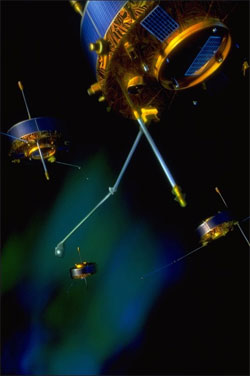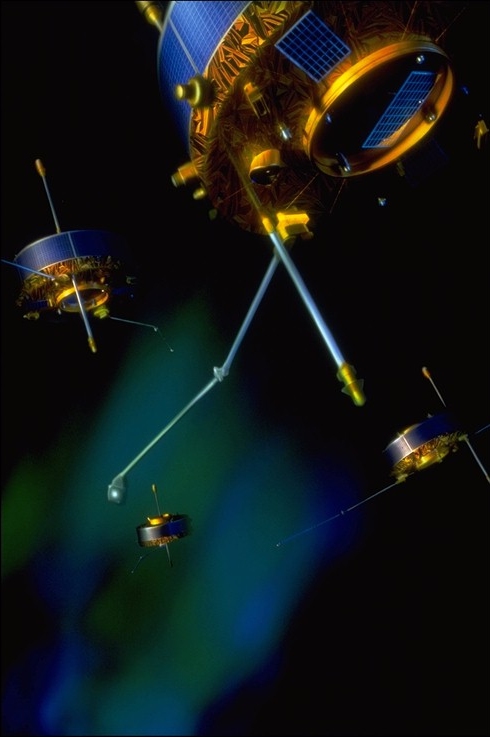Mapping Turbulence in the Solar Wind
Charged particles streaming from the sun don’t just flow smoothly through interplanetary space, but it’s hard to know exactly how they move. In the 30 April Physical Review Letters, a team reports studying the turbulent flow of solar wind particles by monitoring the accompanying waves of magnetic field. The team used a cluster of satellites to measure the field in unprecedented spatial detail. They found that the waves aren’t equally strong in all directions but are larger in certain preferred directions, as theorists had predicted. The observation will help astrophysicists better understand the consequences of the solar wind, including its effect on the transmission of cosmic rays, particles that arrive at Earth from elsewhere in our galaxy.
The solar wind consists mostly of electrons and protons ejected from the sun, moving at hundreds of kilometers per second. This plasma contains a complex and twisted internal magnetic field pattern that is nearly rigid as it rides along on the solar wind. If you pick a small region of the moving plasma, the field is fixed in strength and direction. Amidst this background field there is a roiling plasma turbulence that involves small fluctuations from this field interacting with particle density waves. Ordinary fluid turbulence looks the same in all directions, but “the [background] magnetic field imposes a strong directionality,” says Melvyn Goldstein of NASA’s Goddard Space Flight Center in Greenbelt, Maryland.
To learn more about this complex phenomenon, researchers have used satellites that measure how local plasma properties like the magnetic field change with time. But the variation at a single point only hints at the spatial patterns. Astrophysicists like to think of the turbulent magnetic field fluctuations as a set of waves traveling through the plasma with a wide range of wavelengths. To find the amount of energy contained in waves of each wavelength and direction requires measurements at separate locations. In the new work, Goldstein, Karl-Heinz Glassmeier of the University of Braunschweig in Germany, and their colleagues directly probed the spatial variation of the turbulence using a group of satellites. The four satellites of the Cluster project, jointly sponsored by the European Space Agency (ESA) and NASA, formed a tetrahedron with 1000-kilometer edges, allowing the team to compare the fields at different places.
Glassmeier and his colleagues have been refining data analysis techniques to separate the rapid motion of the solar wind as a whole from the slower propagation of waves within it. Now the researchers have applied the method to the turbulence in the interplanetary solar wind. They found that in a region with a given magnetic field direction, the waves of turbulence that travel perpendicular to the field are more powerful than those moving parallel to it. This result had been suggested by past theory, simulations, and some single-spacecraft measurements, Goldstein says, but “nobody has been able to make a direct measurement.”
The precise geometry of the turbulent fluctuations relative to the magnetic field is important for a variety of phenomena associated with the solar wind. For example, a galactic particle called a cosmic ray travels along magnetic field lines and “feels” a periodic series of jolts, like a ball rolling down a washboard, if it encounters a wave moving in the same direction (parallel to the field line). These bumps make it likely that the particle will scatter and turn to a different course. But if a wave slowly travels perpendicular to the field line, a cosmic ray can simply skate along a ridge or trough and be much less likely to scatter. Researchers have long suspected that these effects help explain the variations of the cosmic-ray flux that is correlated with the regularly repeating cycle of solar activity.
The new results are a “strong confirmation that the turbulence in space is anisotropic,” says Vincenzo Carbone of the University of Calabria in Italy. But even the 1000-kilometer spacing of the Cluster spacecraft is too small to see how the flow develops on the planetary scale, he says. “We need larger scales to fully understand the origin of the anisotropy.”
–Don Monroe
Don Monroe is a freelance science writer in Murray Hill, New Jersey.
More Information
CLUSTER Mission Home Page at the European Space Agency





